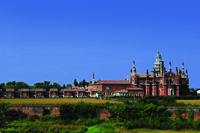Marina Spironetti gets off the beaten track in Milan and uncovers a surprising side to the capital of fashion ? one with peaceful residences and Venetian-style canals…
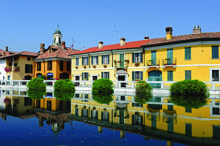 The name says it all: Milano, from the Latin Mediolanum, coming in turn from the Celtic Midland, ?land in the middle?. In the middle of what? Water. As simple as that. The territories around Lombardy?s capital are naturally water-bound: a rectangle marked out by the lakes (Maggiore, Lugano and Como) in the north and the rivers Ticino, Po and Adda on the other three sides. In addition, there is an intricate network of man-made waterways converging into the city ? an ideal extension of all those lakes and rivers. The so-called Navigli are an ambitious project of navigable canals built over seven centuries. The dream of the Sforzas and the Viscontis, the two ruling families of Milan, of Leonardo da Vinci with his hydraulic plans, of Napoleon and the Habsburgs. And, above all, the product of the ingenious, hard-working Milanese who had to deal with a city with no river of its own in a world where water meant commerce and, therefore, wealth.
The name says it all: Milano, from the Latin Mediolanum, coming in turn from the Celtic Midland, ?land in the middle?. In the middle of what? Water. As simple as that. The territories around Lombardy?s capital are naturally water-bound: a rectangle marked out by the lakes (Maggiore, Lugano and Como) in the north and the rivers Ticino, Po and Adda on the other three sides. In addition, there is an intricate network of man-made waterways converging into the city ? an ideal extension of all those lakes and rivers. The so-called Navigli are an ambitious project of navigable canals built over seven centuries. The dream of the Sforzas and the Viscontis, the two ruling families of Milan, of Leonardo da Vinci with his hydraulic plans, of Napoleon and the Habsburgs. And, above all, the product of the ingenious, hard-working Milanese who had to deal with a city with no river of its own in a world where water meant commerce and, therefore, wealth.
My own journey into what is left of this ?Venetian? Milan starts from the Navigli district, southwest of the centre. Just off Porta Ticinese, the Darsena is still there. Now little more than a pond surrounded by the traffic of the boulevards, this was once the dock, the focal point of the complex system of waterways that criss-crossed the city in the Middle Ages ? Milan?s beating heart, with workshops, warehouses, public housing blocks and sailor?s inns. Nowadays only two surviving canals meet there, the Naviglio Grande and the Naviglio Pavese. In recent times, the working class district has turned into one of Milan?s coolest hotspots ? anything from student hangouts to legendary jazz clubs can be found as you stroll along the embankments.
It all starts with the Naviglio Grande, the first and most important waterway of Milan. It stretches for 50km and connects the city to Abbiategrasso before bending towards the Ticino river. Back in the 12th century, it was conceived to irrigate the surrounding farmland. About 100 years later, it became navigable and gained strategic importance, turning into a true commercial lifeline. A slow procession of barges brought all sorts of goods in and out of the city ? in came the food supplies from the countryside, as well as coal and salt; out went local products such as rice, linen and wheat. Even the marble used to build Milan?s Duomo came by water ? and, in more recent times, paper used by the printing rollers of Corriere della Sera, one of Italy?s best-known newspapers.
In spite of its name, nowadays it?s little more than a stream, at least for the first stretch that flows through the city. Echoes of the old Milan are still everywhere, though. The charming case di ringhiera, for example: the old-fashioned Milanese apartment blocks with the front door opening onto
a courtyard with railed walkways leading onto the flats of the upper floors. Houses built to socialise ? a reminder of the working class that lived in the area until not long ago. A few artists? workshops can still be seen on the lower floors ? a faded image of those times when the Navigli district was the Montparnasse of Milan, immortalised in the verses of Alda Merini, one of the city?s most-loved poets.
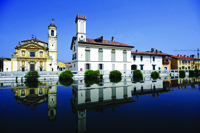 As soon as you leave the city behind, after the Gothic church of St Christopher and the disused Richard-Ginori factory, the atmosphere changes. The Naviglio turns into a proper river, flowing quickly through the flat countryside. Some hidden gems are there to be discovered ? places like Robecco sul Naviglio and nearby Cassinetta di Lugagnano. Both were holiday resorts for the Milanese nobility ? hence the very high number of villas and gardens that can still be seen today. In Robecco, a must-see is the 14th-century Villa Gandini, also known as Villa Gaia (joyous), referring to those happy times when it was Ludovico il Moro?s playground. Just opposite is Palazzo Archinto, known as il Castello because of its crenellated towers. My favourite, though, is the river front in Gaggiano, halfway between Milan and Abbiategrasso. Low, brightly-coloured historic buildings reflect in the running water of the canal, with the Baroque fa?ade of the church of Sant?Invenzio as the main focal point. The combination of bold hues ? yellow, green and pink ? and water almost gives the illusion of being on an island in the Venetian lagoon.
As soon as you leave the city behind, after the Gothic church of St Christopher and the disused Richard-Ginori factory, the atmosphere changes. The Naviglio turns into a proper river, flowing quickly through the flat countryside. Some hidden gems are there to be discovered ? places like Robecco sul Naviglio and nearby Cassinetta di Lugagnano. Both were holiday resorts for the Milanese nobility ? hence the very high number of villas and gardens that can still be seen today. In Robecco, a must-see is the 14th-century Villa Gandini, also known as Villa Gaia (joyous), referring to those happy times when it was Ludovico il Moro?s playground. Just opposite is Palazzo Archinto, known as il Castello because of its crenellated towers. My favourite, though, is the river front in Gaggiano, halfway between Milan and Abbiategrasso. Low, brightly-coloured historic buildings reflect in the running water of the canal, with the Baroque fa?ade of the church of Sant?Invenzio as the main focal point. The combination of bold hues ? yellow, green and pink ? and water almost gives the illusion of being on an island in the Venetian lagoon.
TO THE CHARTERHOUSE
The city?s second canal, Naviglio Pavese, links Milan to Pavia. The connection between the two cities was a challenge that lasted some five centuries. It began back in 1359 with the Visconti family, who started the construction of a canal for irrigation purposes. It was only under Napoleon that it was inaugurated as a transport system. The Milanese dream became true: the sea could be reached through the Naviglio Pavese and the Po river, Lake Maggiore through the Naviglio Grande and the Ticino river and Lake Como through the Naviglio della Martesana and the Adda river.
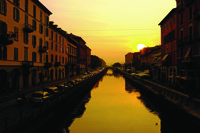 Narrower than nearby Naviglio Grande and flanked by more modern buildings, the only barges that can be seen here are permanently moored and serve as clubs and restaurants, catering for Milan?s bohemians.
Narrower than nearby Naviglio Grande and flanked by more modern buildings, the only barges that can be seen here are permanently moored and serve as clubs and restaurants, catering for Milan?s bohemians.
Apart from Pavia, the ancient capital of the Lombard kingdom, which is worth a visit in its own right, the most impressive highlight along this water vein is the nearby Certosa, Pavia?s Charterhouse. Yet another dream of the Viscontis ? Gian Galeazzo laid the cornerstone in 1396 with the desire of a pantheon for himself and his family (his tomb is inside, as well as those of Ludovico il Moro and his young bride Beatrice d?Este).
The Charterhouse comes out of nowhere, a beckoning vision in the middle of the Lombard plain, with its marvel of polychromatic marbles, medallions, statues, bas-reliefs and embroidery. It?s a place for meditation, far away from Milan?s frenetic atmosphere. I sit down on one of the benches in the large grassy courtyard, overwhelmed by the richness of the vision I have before my eyes. All around is perfect quietness, occasionally broken by the steps of a few visitors walking down the chipping path. The monks of today live the same simple, contemplative life as their predecessors, maintaining vows of silence ? apart from a few who take visitors around the complex.
A PEACEFUL RIDE
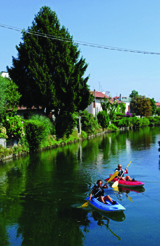 Whenever you want to run away from the hustle and bustle of the city, it is sufficient to get on a bike and cycle along the third and least-known canal of Milan, the Naviglio della Martesana. A 38km-long ciclovia (bike lane) starts from Via Melchiorre Gioia, not far from the tracks of the Stazione Centrale, Milan?s main railway station, and follows the canal all the way to the Adda river. Really one of the best city hideaways, this Naviglio flows through some charming little towns. The most picturesque one is Gorgonzola ? yes, the town of the cheese ? with its wooden bridge, the Church of Saints Gervasio and Protasio and its tiny cobbled passageways. Every time I stop to take a picture, I engage in conversations with locals ? all very proud of their territory. An elderly lady who is in the mood for a chat tells me how she used to sneak out of the hospital every morning after an operation simply to admire the view.? ?It made me recover faster,? she says.
Whenever you want to run away from the hustle and bustle of the city, it is sufficient to get on a bike and cycle along the third and least-known canal of Milan, the Naviglio della Martesana. A 38km-long ciclovia (bike lane) starts from Via Melchiorre Gioia, not far from the tracks of the Stazione Centrale, Milan?s main railway station, and follows the canal all the way to the Adda river. Really one of the best city hideaways, this Naviglio flows through some charming little towns. The most picturesque one is Gorgonzola ? yes, the town of the cheese ? with its wooden bridge, the Church of Saints Gervasio and Protasio and its tiny cobbled passageways. Every time I stop to take a picture, I engage in conversations with locals ? all very proud of their territory. An elderly lady who is in the mood for a chat tells me how she used to sneak out of the hospital every morning after an operation simply to admire the view.? ?It made me recover faster,? she says.
Initially named Naviglio Piccolo, this canal was built by Francesco Sforza in 1475 as a way of moving ?grindstones, oil torches, spinning wheels, paper mills? and it was completed within three years. Navigation was precise but painfully slow: it took seven and a half hours for the barges to reach Milan and 12 hours to go back, towed by horses. After all, the very nature of the Navigli goes against the idea of their being easily navigable. They are never too wide or too deep, as they were designed for a time when the engine had not yet been invented and barges were towed by animals or carried along by the current. Still, up to the 1950s these canals handled more tonnage than a seaport like Brindisi. Once again, Milan did manage. Somehow, that dream of an inland city that wanted to be by the sea became true. Not bad, considering it does not even have a river.

